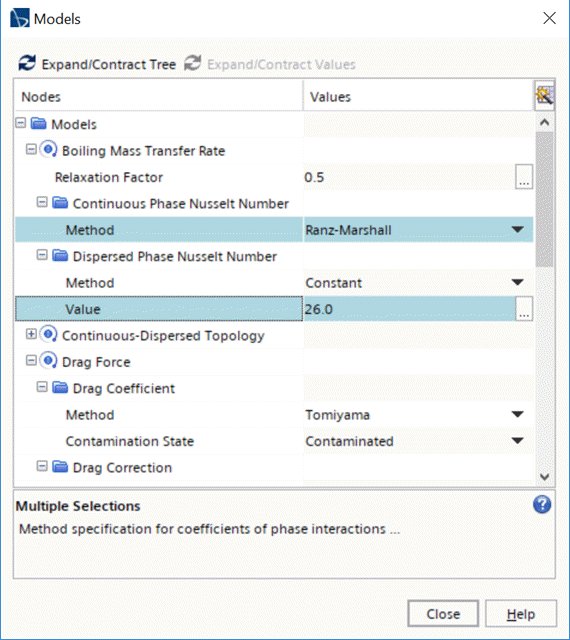Defining the Phase Interaction Properties
Define the interactions between the phases.
The main modeling choice that is made here is the use of the combination of Hibiki-Ishii Nucleation Site Number Density and Kocamustafaogullari Bubble Departure Diameter. This combination of models is applicable for water boiling under a wide range of pressures. The default models (Lemmert-Chawla and Tolubinsky) are much simpler, but can need testing and recalibration for use at different pressures.
As a wide range of volume fractions is expected, ensure that the Interaction Area Density model uses the Symmetric method.
To define the phase interaction properties:
-
Edit the node and set the following properties:
Node Property Setting Method Ranz-Marshall 
Value 26.0 Method Tomiyama 
Method Volume Fraction Exponent Volume Fraction Exponent (continuous) 0.0 Method Symmetric Method Field Function Scalar Function ClippedSauterMeanDiameter Method Hibiki-Ishii  Bubble Departure Diameter
Bubble Departure Diameter
Method Kocamustafaogullari 
Selecting the Ranz-Marshall option makes Simcenter STAR-CCM+ calculate the Continuous Phase Nusselt Number using the Ranz-Marshall correlation. The Ranz-Marshall correlation, in turn, is used to calculate the heat transfer coefficient for the heat transfer from the bulk water to the bubble interface.
The Disperse Phase Nusselt Number is used when calculating the heat transfer coefficient for the heat transfer from the bubble interface to the bulk steam. The exact value is not critical because the vapor is going to be at, or close to, saturation temperature. A value of 2 represents a slow response with little internal circulation. A higher value such as 26 can represent either a fast superficial response or the effect of internal mixing within the vapor.
The Tomiyama model is used for modeling bubbly flows. Drag reduction is not expected for small spherical bubbles.
The Turbulent Dispersion Force setting is important for wall boiling calculations in the presence of condensation because it treats the differencing of rapidly changing volume fraction gradients more accurately. Without this setting, the simulation can get unusual velocities at the edge of the spreading bubble cloud as well as unnecessary convergence difficulties.
The Interaction Length Scale is based on the bubble size predicted by the S-Gamma model. The ClippedSauterMeanDiameter field function is one of the user-defined field functions that was created earlier. This setting allows the Sauter Mean Diameter that is predicted with the S-Gamma model to be used as the interaction length scale for drag and interface transfers. It also filters the calculations through a maximum and a minimum diameter so that early unconverged S-Gamma solutions do not upset convergence.
- Select the node and set the Phase Interaction to Liquid Vapor Interface.
- Save the simulation.